A new weapon that uses radio waves to disable enemy electronics and take down multiple drones at once is under development for the UK’s armed forces, and it only costs 10p per shot.
An example of a Radio Frequency Directed Energy Weapon (RFDEW), the versatile system can detect, track and engage a range of threats across land, air and sea.
The system will be able to effect targets up to 1km away, with further development in extending the range ongoing. It beams radio waves to disrupt or damage the critical electronic components of enemy vehicles causing them to stop in their tracks or fall out of the sky.
At only 10p per shot fired, the RFDEW beam is a significant cost-effective alternative to traditional missile-based, air defence systems, capable of downing dangerous drone swarms with instant effect. The high level of automation also means the system itself can be operated by a single person. This technology can offer a solution to protection and defence of critical assets and bases.
This weapon can take out drones and military vehicles from 1km with #radiowaves.. for 10p a shot
Developed by our experts and partners our tech ensures our Armed Forces are ready for the future https://t.co/oP6YpDiC9u@jcartlidgemp @DefenceHQ @DefenceES @BritishArmy @ThalesUK pic.twitter.com/1YNmdB1Gan
— Dstl (@dstlmod) May 16, 2024
Minister for Defence Procurement, James Cartlidge said:
“We are already a force to be reckoned with on science and technology, and developments like RFDEW not only make our personnel more lethal and better protected on the battlefield, but also keep the UK a world leader on innovative military kit.
The war in Ukraine has shown us the importance of deploying uncrewed systems, but we must be able to defend against them too. As we ramp up our defence spending in the coming years, our Defence Drone Strategy will ensure we are at the forefront of this warfighting evolution.”
Dstl Chief Executive, Paul Hollinshead said:
“These game changing systems will deliver decisive operational advantage to the UK armed forces, saving lives and defeating deadly threats.
World class capabilities such as this are only possible because of decades of research, expertise and investment in science and technology at Dstl and our partners in UK industry.”
RFDEW technology can be mounted on a variety of military vehicles and uses a mobile power source to produce pulses of Radio Frequency energy in a beam that can rapidly fire sequenced shots at individual targets or be broadened to simultaneously engage all threats within that beam.


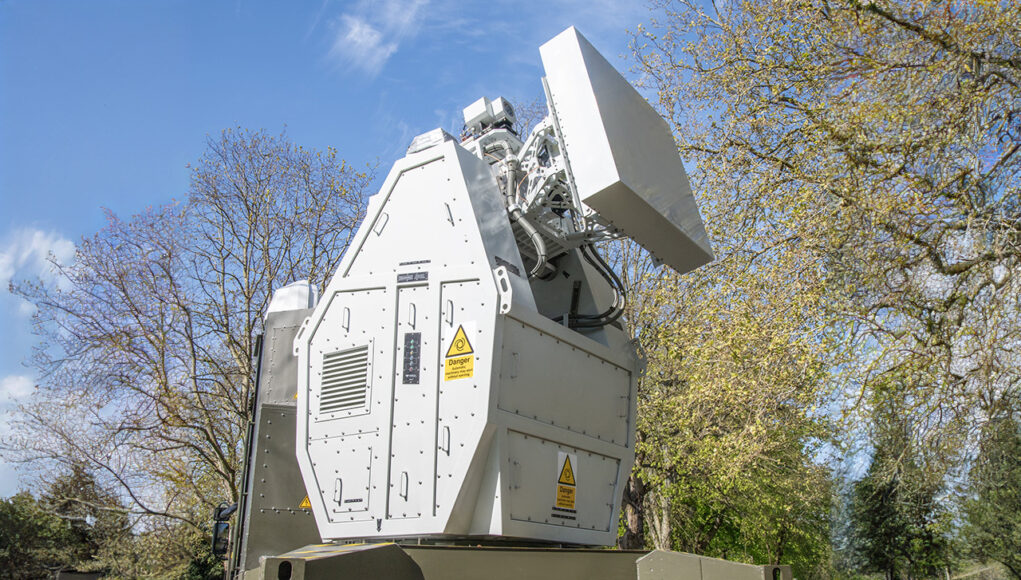


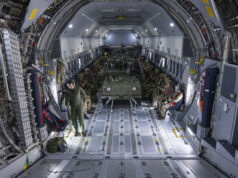
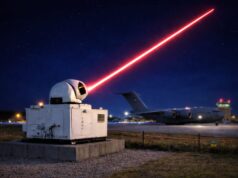

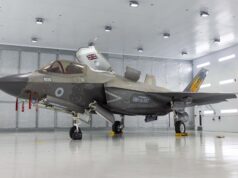
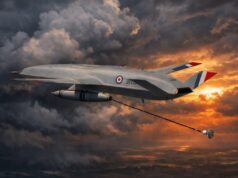

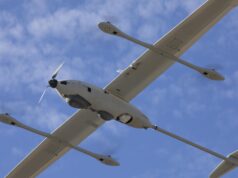


Americans have now more hope on this than lasers
(…)
“You may have a 50-kilowatt laser, [but] at 10 kilometers can you put at least four kilowatts in a centimeter square because … that’s what you need to burn through a quarter inch steel plate?” the three-star general asked. “But that’s really hard to get … from a big beam to get the small portion of it on the exact spot to be able to burn at that high intensity and any kind of dust particle or that starts to disrupt that.”(…)
From Breakingdefense
This was shown weeks ago on Twitter. Apparently on display at Baker Bks with 7 ADG of the Field Army. So 12 and 16 RA.
As GB said on Twitter, why Pussers Grey. Going to the RN too?
This is a reannouncement of Project Ealing from 2020/21. So GBAD, not RN. Thales is running it. Project Tracey (maritime laser) was cancelled at the start of the year, ostensibly to get more money into this and Raytheon’s Project Swinton (Wolfhound-based laser).
Maybe it inherited the paint from Project Tracey.
Hi Jon.
Thanks for that.
And what exactly, is wrong with Pussers Grey my good chap!!😂
😆 Lots, if it’s fielded by the army my good man!
Which let’s be honest Shapps will be trying to do in offering it to Ukraine anytime now… unless they have got that muzzle working.
First it was Dragon Fire at £10 a shot and know RFDEWs at 10p a shot.
Soon is will be 10 a penny. For slow simple threats it makes sense. Perhaps easier than Lasers.
Reminiscent of the 1930s ‘Flash Gordon’ type death rays that become Radar.
Full circle I guess as that’s how radar indeed started out, thank God we didn’t need it to win the war.
10p per shot is what was claimed for the laser too. Yet our major destroyers have had to have upgrades because they couldn’t cope with oerating in warm sea. The power needed by these systems will surely stress further our under armed and badly design ships?
This is brilliant news, can it also be used on warships or am I missing something?
I struggle to understand how these things work i.e. how they make things fall out of the sky.
What part of the “keeping things up in the sky” system do they affect and how?
What sort of targets are they effective against? Would the effect be different if it was pointed at, say, a Predator-style UAV or an incoming Anti-ship missile?
I just want to understand the roles in which this thing could be used. If the effect is more general purpose then it could be put on aircraft, to divert or knock down incoming AAMs, or if it was limited to just slow, command controlled things it would mainly be limited to ground use on a battlefield.
Hi SB, probably an effective way of dealing with the bulk of low-end drones made today. As this article perhaps implies, generate a burst of radio frequency energy with enough power to damage the front end of any drone receiver or, perhaps, disrupt the control link between operator and drone. So I’m guessing the antenna is some form of steerable panel array with a sharp enough radio beam to concentrate the energy in a pencil like beam? Just needs management of any side/back lobes so these don’t damage/swamp anything on the host platform. The latter might mean exclusion arcs of fire.
Well if the electronics are frazzled depending upon what the target actually is not much will work as nominally as desired. Small drones would as shown likely drop out of the sky certainly lose all control but obviously anything big and fast isn’t going to be stopped in a mile or so though still might have some potential or minor beneficial effect perhaps. Range needs to be expanded a good bit but clearly they know that. On the battlefield could be very useful against drones especially covering troops or vehicles as they move as long as they are detected of course which is an area that needs advancement in my view as plenty of weapons have been taken out that could have engaged them if they had been detected soon enough.
I understand, but what actually Frazzles the electronics? I could understand if there was a complex computer involved then a powerful RF pulse could muck up transistors and scrambled inputs irreparably but most small drones are not that complex so would not be affected as severely.
I also get that a microwave pulse will blow out and damaged the sensors of anything operating in that band, but that must be a small proportion of available targets.
I suppose it must just be the interruption of electrical circuits for long enough for the target to be distracted or for further commands to have unintended effects due to damage caused by the pulse, but I’m struggling to work out how effective that would be.
Must just be a whole heap of EM going on.
Hi SB,
RF energy damages electronic components by coupling with external parts of the target and generating an electric current, basically it is the same process as a radio aerial. If there is an electrical connection, or a week point in the insulation, between the external components and the electronic systems then there is a route for the electrical energy to transfer into the electronics.
The generated electrical energy can cause a temporary failure by driving a circuit to saturation or circuits can be destroyed overloaded and burning out.
In the case of a drone that requires external commands the drones aerial will be an obvious means for the RF energy to couple into the drones systems. Basically the flight control system will likely be fried… that would be a hard kill.
If an autonomous vehicle with suitable hardening is approaching, but it is carrying RF sensors then it is likely that the senors would be the most vulnerable parts of the system, so a mission kill is the most likely result of an engagement.
This is grossly over simplified obviously.
Hope it helps.
Cheers CR
Thanks CR, that’s exactly what I was looking for.
Also aren’t some of these FPV drones we’re seeing being used in Ukraine based on cheap retail drones that are mostly quadcopter models? I don’t know for sure but I’m guessing there’s a pretty decent amount of onboard processing going on even in the absence of any control input from an operator to take gyroscope and/or accelerometer inputs to automatically keep the thing stable so that some 10 year old can buy one from Amazon and fly it in his/her back garden with a joystick control rather than having to have the skills of a helicopter pilot just to keep it in the air. For those sort of drones I wouldn’t be surprised if zapping the onboard CPU would pretty quickly cause the drone to become unstable and drop out of the sky.
Simple answer – yes.
I suspect that the kind of damage you describe would generate an instant response from a small light weight quadcopter i.e. it is likely to flip over and drop out of the sky the moment any spurious current is driven into the system / motors causing asymmetric lift on the rotors.
Cheers CR
Just the man to explain. Thank you.
It’s a transfer of energy which may have nothing to do with the target electronics operating at the same frequency, although that would certainly push the process along. Think of a microwave oven. You wouldn’t cook your mobile phone believing it safe because 4G doesn’t use the same frequency as the oven. Your chicken still defrosts despite having no circuitry in it whatsover, but circuitry is the easiest to induce a current in and that’s what will is likely to overload first in an attack.
Ah, that’s what I needed
“Overload the circuitry”
So the RF pulse just induces a large enough current in the circuits to damage components etc.
I knew revising for GCSE physics was worthwhile.
I was about to use the “don’t put your smartphone in your microwave” explanation but Jon beat me to it.
This type of weapon is highly effective but also comes with problems.
It’s not a tightly focused laser, it’s more of a cone of electronics destroying microwave energy.
So would this approach work on a warship? Yes.
But if you fire this off in the middle of London it may be 10p a shot but you just fried £100 million in electronics that happen to be in the general direction of the drone.
Not just mobile phones, but computers inside of buildings, police radios, traffic management infrastructure, engine management circuits in your car engine etc etc
I do to. We know about the radio pulse from atomic bomb that kills all electronics circuits in a given area. May be same principles are used. It is possible to protect circuits from these kind of threats, this would increase the costs of drones… I don’t think they aim for a signal spoofing with this kind of kits, may be they do. Though, French manufacturers already provided to Ukrainian army drones that are not GPS dependent and that can work despite severe electronic jamming. I only guess this system is more powerful.
As far as I am concerned, I tend to prefer 40mm canon, it is more versatile. I guess to protect cities or various critical installations in densely populated areas, systems like that can be very useful. Another advantage may be the discretion of the system.
The issue with guns to protect infrastructure a d the like is that there are still physical objects flying through the air and you have to think about where debris lands, even if like most airburst the shell is timed to detonate after a set period.
Where this is really useful is, as you say, near cities or in other places where the risk of collateral damage is too great with conventional arms.
They burn the electronics. Radar/radio is energy and radiation. If powerful enough can even burn a human.
radio waves are a form of electromagnetic radiation. Electromagnetic radiation causes electromagnetic induction in electronics and wires that are part of a circuit..this creates an induced current that will flow…not healthy for modern electronics…
Its the same reason everyone is a bit worried about a Carrington event..a huge great solar flare that happened in 1859..basically even with the very basic electrical systems of the time it causes destruction, fires and interesting effects…infact telegraph systems at the time had to turn all their power supplies off…but still operated and worked due to the induced current.
EMP is your friend.
I bet the Chinese come up with one that looks very, very much like ours, its weird most of their kit look like other peoples who built it first.
Currently 10p per shot but as there was a 5% use of non UK electronic systems it will need to be re manufactured as a pure bespoke British system, using only British parts, using British only components and companies, ensuring 3 jobs are maintained at a number of factories, for a period of 14 years, with a new in service date of 2035, at a competitive price of 35 million per shot, with a total of 2 systems in use 😇😵💫😆
That wouldn’t be anywhere near as funny if it wasn’t a half truth.
Ello ello, look who the cat dragged in..hello mate.
Hi mate you ok? Not been waffling on here much, moved, full house renovation and still working full time, but always get an opportunity to read the posts but not comment as often! Hope all is well with you mate 👍
Yes mate. Glad you’re still about if only lurking. You’re missed.
Work is overrated mate….got my retirement planned for this summer..so I can spend all my time waffling on this site.
Great but how good is this if you shield the drones electronics in a faraday cage?
We already have EMP resistant electronics would that not be an obvious counter to this sort of kit. I prefer kinetic solutions.
The answer to the question, would depend how well shielded the drone was and what power beam was being aimed at it. It only takes a few joules of energy to potentially inflict damage in sensitive electronics. At a range of one kilometre a 1kw radio beam could easily inflict such damage. Shielding the drone makes it more expensive and heavier and requires careful engineering. Just buying gear off the shelf and making DIY drones like in Ukraine, wouldn’t work. This weapon has the potential to make those tactics no longer viable.
We don’t know . Numbers, Frequency? Continuous wave? protection weight etc etc is what matters and we don’t have that.
OK this has been around for a while and like laser it’s biggest problem is energy and energy density. EW and specifically DEW has been on ships for a while ad they have lots of energy and large directional radiators, especially on Type 45.
To get a good effect a modulated signal is used, usually pulsed, to generate a high peak power compared to CW (continuous wave), which also gives a broadband effect rather than a single frequency for CW.
Next is the ability to effectively radiate and direct which in the past used parabolic antenna, which limited the power because of the single element at the centre of the antenna. Now with with steerable array antenna this is no more a limitation.
Effectively you either disrupt the communication link (easy), disrupt the internal processing (harder) or fry the components (hardest). Military grade drones are designed with levels of protection against DEW which is why they are bigger and a lot more expensive than COTS drones.
Just don’t stand in front of it when it’s working, you may start to feel a little warm, dizzy or potentially dead.
Nerd mode off….
I do love the whole 10p per shot thing….it’s not really..you have to take the cost of development, cost of manufacture, cost of training, cost maintaining and deploying then divide it by they total number of shots taken during the life of the system…that gives you cost per shot.